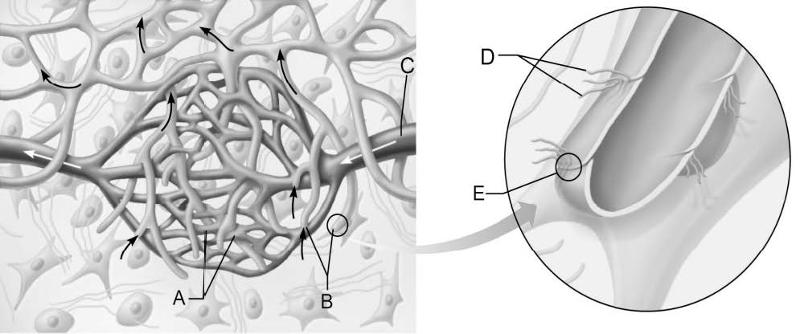
Identify the letter that indicates the unique arrangement of
endothelial cells that comprise
lymphatic capillaries.
A)
A
B) B
C) C
D) D
E) E
E
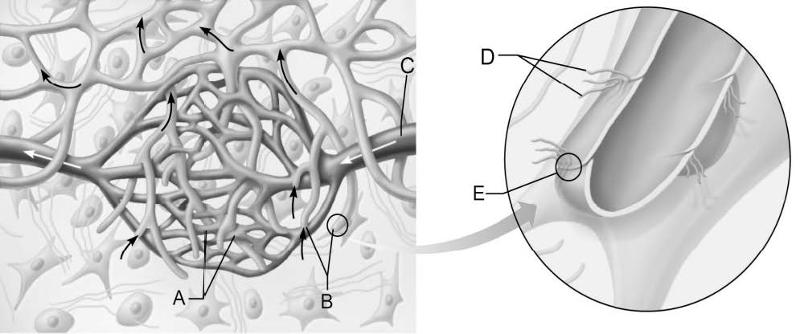
Identify the letter that indicates collagen fibers that anchor
lymphatic capillaries to
surrounding connective tissue.
A)
A
B) B
C) C
D) D
E) E
D
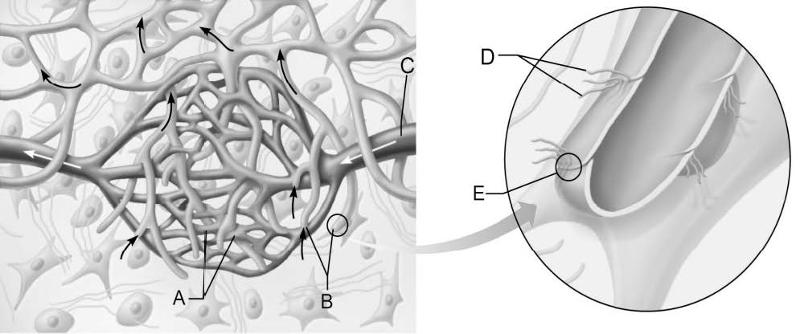
Identify the letter that indicates the smallest lymphatic vessel that
collects lymph in the
peripheral tissue.
A) A
B)
B
C) C
D) D
E) E
B
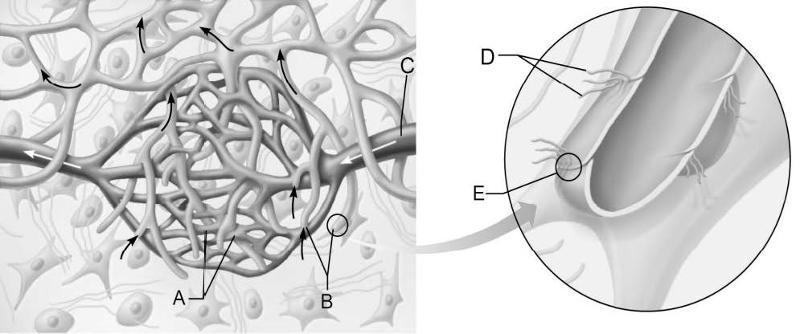
Identify the letter that indicates a vessel that carries oxygenated
blood to peripheral tissues.
A) A
B) B
C) C
D)
D
E) E
C
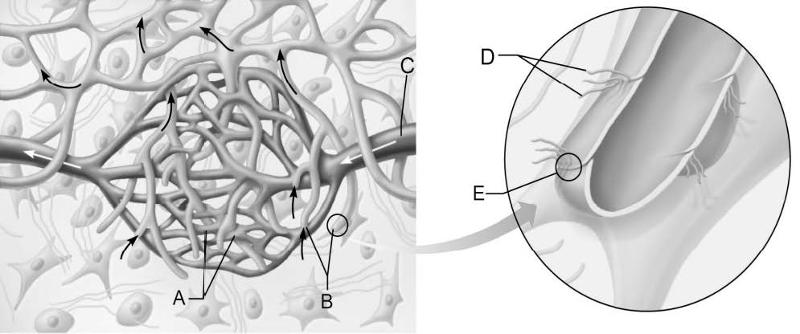
Identify the letter that indicates a vessel that carries deoxygenated
blood away from peripheral
tissues.
A) A
B) B
C)
C
D) D
E) E
A
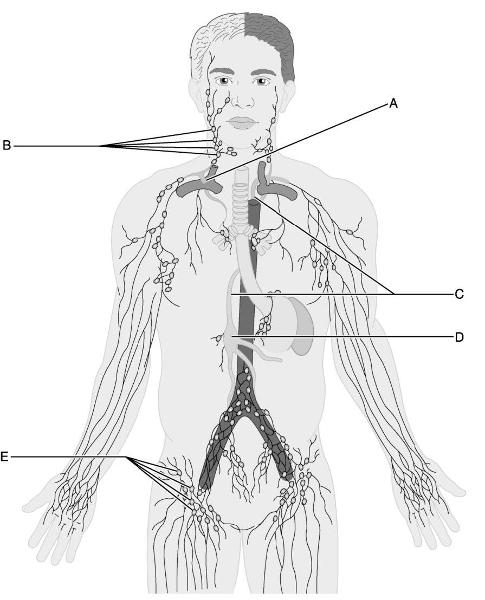
Identify the letter that indicates lymph nodes that direct lymph
fluid to the jugular trunks.
A) A
B) B
C) C
D)
D
E) E
B
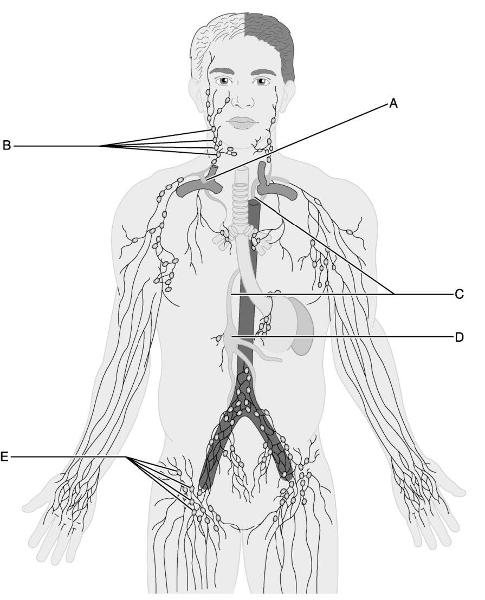
Identify the letter that indicates the large lymph vessel that drains
three-quarters of the body.
A) A
B) B
C) C
D)
D
E) E
C
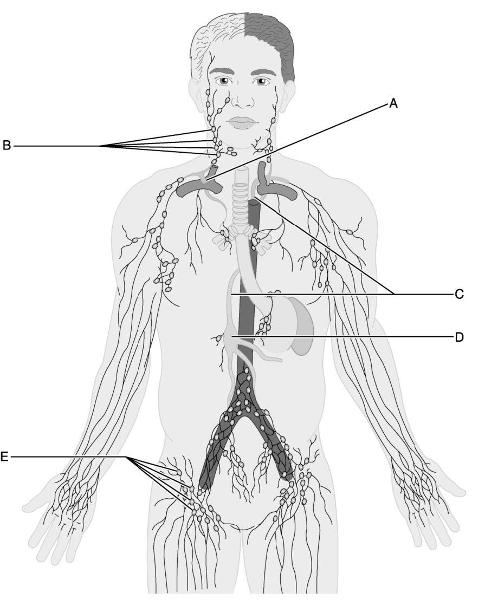
Identify the letter that indicates the union of the right jugular,
subclavian, and
bronchomediastinal trunks.
A) A
B)
B
C) C
D) D
E) E
A
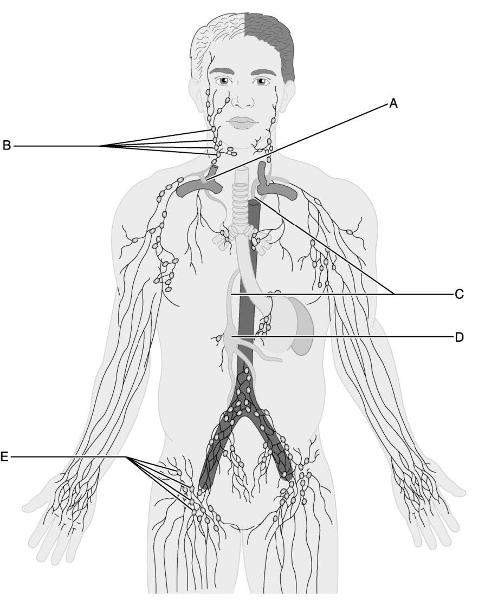
Identify the letter that indicates inguinal lymph nodes that filter
lymph from the lower limbs.
A) A
B) B
C) C
D)
D
E) E
E
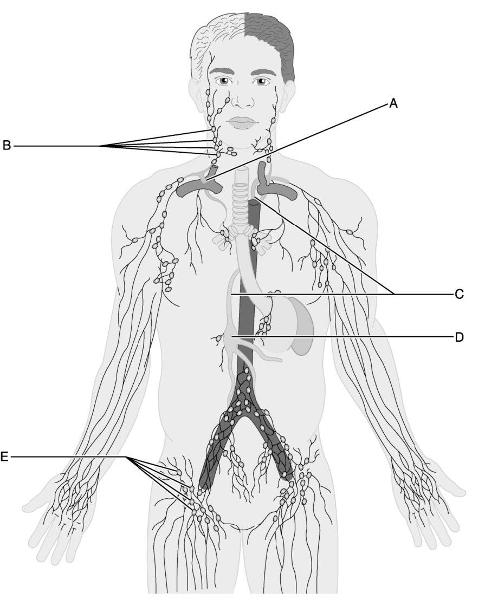
Identify the letter that indicates the first structure to receive
lymph from both the lumbar and
intestinal trunks and is located
on the surface of L1 and L2 vertebrae.
A) A
B) B
C)
C
D) D
E) E
D
Structures comprised of endothelial cells separated by flaplike
minivalves that are opened as
fluid accumulates in peripheral
tissue describes
A) blood capillaries.
B) lymph
nodes.
C) lymph capillaries.
D) cisterna chyli.
E)
thoracic duct.
C
Set of lymphatic capillaries that collect fat-laden fluids from the
intestinal tract.
A) lumbar trunks
B) subclavian
trunks
C) bronchomediastinal trunks
D) lacteals
E)
intestinal trunk
D
Two-lobed lymphoid organ located posterior to the sternum.
A)
cisterna chyli
B) thymus
C) MALT
D) lacteals
E) crypts
B
Recycles red blood cells and initiates immune responses.
A)
tonsils
B) lymph nodes
C) MALT
D) spleen
E) thymus
D
Lymphoid organs located in the mucosal lining of the pharynx.
A)
tonsils
B) salivary glands
C) uvula
D) pharygotympanic
tube
E) aggregated lymphoid nodules
A
Begins at the cisterna chyli.
A) thymic corpuscles
B)
aggregated lymphoid nodules
C) thoracic duct
D) MALT
E)
inguinal lymph nodes
C
Small, bean-shaped organs abundant in the cervical, axillary, and
inguinal regions.
A) lymphatic capillaries
B) afferent
lymphatic vessels
C) lymphatic ducts
D) lymph nodes
E) lacteals
D
Large lymphatic vessel that if present, is comprised of the right
subclavian trunk, right
jugular trunk and right
bronchomediastinal trunk.
A) cisterna chyli
B) MALT
C)
spleen
D) thoracic duct
E) right lymphatic duct
E
T cells gain immunocompetence in this lymphoid organ.
A)
thymus
B) tonsils
C) spleen—red pulp
D) lymph
nodes
E) spleen—white pulp
A
The largest lymphoid organ.
A) thymus
B) tonsils
C)
aggregated lymphoid nodules
D) lymph nodes
E) spleen
E
Masses of lymphoid tissue within a lymph node.
A)
trabeculae
B) hilum
C) lymphoid follicles
D) white
pulp
E) subcapsular sinus
C
The lymphoid organ that atrophies with age.
A) thymus
B)
tonsils
C) aggregated lymphoid nodules
D) lymph
nodes
E) spleen
A
Duct of the lymphatic system that drains the body's entire lower
half.
A) lumbar trunk
B) intestinal trunk
C)
bronchomediastinal trunk
D) thoracic duct
E) right lymphatic duct
D
Lymphoid tissue associated with the digestive, respiratory, urinary,
and reproductive tracts.
A) aggregated lymphoid nodules
B)
tonsils
C) MALT
D) lacteals
E) crypts
C
Blind-end invaginations of tonsil epithelium that trap bacteria and
particulate matter.
A) aggregated lymphoid nodules
B)
tonsils
C) MALT
D) lacteals
E) crypts
E
Which of these statements regarding lymph capillaries is
false?
A) They begin as closed-ended tubes.
B) They have
precapillary sphincters that regulate drainage of lymph from
tissues.
C) They lack barriers to stop cancer cells from entering
the lymphatic system.
D) They unite with each other to form
collecting vessels.
B
The sinuses within lymph nodes
A) are separated from the
bloodstream by a blood-node barrier.
B) consist of star-shaped
epithelial cells that secrete immune-boosting hormones.
C)
contain macrophages living along a reticular fiber network.
D)
surround clumps of lymphoid tissue called white pulp.
C
Given that a germinal center arises from a single activated
lymphocyte, how many different
kinds of antibodies are secreted
by a single germinal center (and by the plasma cells
it
produces)?
A) none; T cells do not produce
antibodies
B) one
C) several dozen
D) thousands
B
The largest kind of lymphatic vessel is a lymphatic
A)
duct.
B) trunk.
C) sinus.
D) capillary.
A
Lymphatic capillaries are present in
A) skin.
B)
teeth.
C) the central nervous system.
D) bone marrow.
A
Lymphocytes attack antigens mostly in lymphoid organs (except the
thymus) and in
A) loose connective tissue.
B) the
bloodstream.
C) cartilage.
D) the thyroid.
A
In the spleen, lymphoid tissue is confined to the
A) red
pulp.
B) white pulp.
C) trabeculae.
D) hilus.
B
Is it possible for lymphocytes to gain immunocompetence in the thymus
of an 82-year-old
person?
A) Yes, but the thymus has shifted
to the production of B lymphocytes.
B) Yes, but fewer than in
youth.
C) No, because the thymus has completely
degenerated.
D) No, because all lymphocytes have turned into
thymic corpuscles.
B
The immune system cell type that is preferentially destroyed by the
Epstein-Barr virus in
mononucleosis is the
A) B
lymphocyte.
B) cytotoxic T lymphocyte.
C) helper T
lymphocyte.
D) macrophage.
A
A bubo is
A) an infected lymph node containing a large number of
pathogens that are trapped in the node
but not destroyed.
B)
a cancer-infiltrated lymph node.
C) any enlarged lymph
node.
D) a structure that is unrelated to lymph nodes.
A
In humans, B lymphocytes originate in
A) the thymus.
B) the
appendix.
C) all lymphoid tissue.
D) the bone marrow.
D
Which of the following cells are the largest producers of
antibodies?
A) B lymphocytes
B) T lymphocytes
C) plasma
cells
D) macrophages
C
The lymph trunk that contains chyle and is unpaired is the
A)
intestinal.
B) subclavian.
C) jugular.
D) right lymph trunk.
A
Which of the following statements about the right lymph duct is
false?
A) Not all people have one.
B) This duct and its
tributaries drain the superior right quarter of the body.
C) It
empties into the thoracic duct.
D) It forms from the union of a
jugular, subclavian, and bronchomediastinal trunk.
C
In a histological cross section through an artery, a vein, and a
lymphatic vessel, one can
recognize the lymphatic vessel because
it
A) has the fewest valves.
B) has the thinnest
walls.
C) has the thickest tunica media.
D) always lies
closest to the artery, which has the thinnest walls.
B
Which of the following is not a part of MALT?
A) lymphoid tissue
in the appendix
B) lymphoid tissue in the tonsils
C)
aggregated lymphoid nodules
D) lymphocytes in the spleen
D
Which of the following lymphoid structures have a hilum?
A)
tonsils and appendix
B) thymus and aggregated lymphoid
nodules
C) spleen and lymph nodes
D) MALT
C
Lymphatic ducts deliver lymph to the cardiovascular system proximal
to the
A) external jugular veins.
B) inferior vena cava just
below the right atrium.
C) internal jugular and subclavian
veins.
D) superior vena cava and azygos vein.
C
In humans, T lymphocytes originate in
A) the spleen.
B) the
thymus.
C) the red bone marrow.
D) the lymph nodes.
C
Blockage of the ________ duct would prevent drainage only from the
________ and lumbar
trunks.
A) right lymphatic;
jugular
B) right lymphatic; subclavian
C) thoracic;
axillary
D) thoracic; intestinal
D
In lymph nodes, follicles are always located
A) in the
cortex.
B) near the hilum.
C) in the lymph sinuses.
D)
in the medullary cords.
A
The lymph organ that lies in the superior part of the thoracic
mediastinum is the
A) cervical lymph node.
B)
spleen.
C) tonsil.
D) thymus.
D
Which of the following is not classified as a lymphoid organ?
A)
liver
B) spleen
C) tonsils
D) aggregated nodules in the intestine
A
The thymus is most active during
A) fetal development.
B)
adolescence.
C) old age.
D) childhood.
D
The tonsil located on the posterior surface of the tongue is the
________ tonsil.
A) palatine
B) pharyngeal
C)
tubal
D) lingual
D
The ________ stores blood platelets.
A) lymph node
B)
thymus
C) tonsil
D) spleen
D
The lymphatic capillaries are
A) more permeable than blood
capillaries.
B) less permeable than blood capillaries.
C) as
permeable as blood capillaries.
D) completely impermeable.
A
B lymphocytes are to ________ as T lymphocytes are to
________.
A) antibodies; antigens
B) antibodies; programmed
cell death
C) antigens; antibodies
D) programmed cell death; antibodies
B
Which cell has the responsibility of presenting foreign antigens to
lymphocytes?
A) cytotoxic CD8+ T lymphocyte
B) dendritic
cell
C) helper CD4+ T lymphocyte
D) natural killer
B
Lymph capillaries differ from blood capillaries in all of the
following ways except that
A) they are more permeable than most
blood capillaries.
B) they carry lymph instead of blood.
C)
they are blind-ended.
D) their walls consist of endothelial cells.
D
Which of the following might explain why most people are sick more
often as children than
as adults in their 20s through
50s?
A) The immune system does not appear until the preteen
years.
B) The thymus is so active in children that it fights
bacteria so hard that it produces strong
symptoms of
disease.
C) Because of their small size, children's bodies cannot
contain as much lymphoid tissue as those
of adults.
D) We
build up many varieties of memory lymphocytes during childhood,
providing immunity
to more and more antigens during adulthood.
D
The bulges that give lymph vessels a string-of-beads appearance are
really
A) lymph nodes.
B) pockets for valves.
C)
weakenings in the wall of the vessels.
D) temporary constrictions
caused by bulging skeletal muscles that squeeze the lymph vessel.
B
Lymphoid tissue contains all of the following elements except
A)
T cells.
B) B cells.
C) follicles.
D) thick collagen fibers.
D
Clusters of lymph nodes occur in all of the following sites
except
A) along the aorta.
B) in the mediastinum.
C) in
bones and bone marrow.
D) in the inguinal region.
C
Because the appendix is a narrow tube, it traps microorganisms from
the digestive tract, and
these microorganisms enter its wall and
activate memory lymphocytes for long-term immunity.
Another
immune organ that traps microorganisms is the
A) thymus.
B)
bone marrow.
C) palatine tonsil.
D) the spleen.
C
The immune system cell type that is preferentially destroyed by the
AIDS virus is the
A) B lymphocyte.
B) cytotoxic T
lymphocyte.
C) helper T lymphocyte.
D) helper B lymphocyte.
C
Which of the following lymphoid organs does not directly fight
antigens?
A) tonsil
B) spleen
C) the thymus
D)
aggregated lymphoid nodules
C
Which cell secretes cytokines that will stimulate the proliferation
of other types of immune
cells?
A) cytotoxic CD8+ T
lymphocyte
B) dendritic cell
C) helper CD4+ T
lymphocyte
D) natural killer cell
C
All of the following mechanisms help move lymph through the lymphatic
vessels except
A) contractions of smooth muscle in the wall of
the lymph vessels.
B) body movements during exercise.
C)
tiny lymph hearts.
D) contraction of skeletal muscles.
C
The lymph trunk that drains the thoracic organs is called the
A)
posterior intercostal trunk.
B) great cardiac trunk.
C)
bronchomediastinal trunk.
D) azygos trunk.
C
The paired lymph trunks that carry lymph from the lower limbs are
the
A) cisterna chyli.
B) iliac trunks.
C) lumbar
trunks.
D) femoral trunks.
C
Lymphatic vessels perform all of the following functions
except
A) returning excess tissue fluid to the
bloodstream.
B) returning leaked blood proteins to the
bloodstream.
C) transporting digested fats.
D) carrying blood.
D
Macrophages that destroy aged and defective blood cells from
circulation are present in the
________ of the spleen.
A)
hilum
B) splenic cords
C) venous sinuses
D) white pulp
B
A lymphoid nodule is
A) a small lymph node.
B) a type of
lymphoma.
C) a bulge in a lymphatic collecting vessel.
D) a
cluster of densely packed lymphocytes.
D
Crypts of the tonsils
A) are filled with lymphoid
tissue.
B) are specialized lymphatic capillaries.
C) contain
all the progeny of a single activated B lymphocyte.
D) trap
bacteria and particulate matter.
D
This organ has a superficial cortex filled with lymphocytes and an
inner medulla with few
lymphocytes and a sizable number of
degenerating epithelial reticular cells.
A) lymph node
B)
spleen
C) thymus
D) tonsil
C
Edema is
A) a form of cancer.
B) an infection of the
lymphatic vessels.
C) an infection of the lymph nodes.
D)
the accumulation of excess tissue fluid in loose connective tissue.
D
One location where lymphoid tissue is found is "in the
frequently infected mucous
membranes of the digestive,
respiratory, urinary, and reproductive tracts." Specifically,
this
refers to
A) intestinal and bronchomediastinal lymph
trunks.
B) the intestinal and tracheobronchial lymph
nodes.
C) the cisterna chyli and lacteals.
D) MALT.
D
Lymph vessels drain lymph from all the lymphoid organs (simply
because lymph vessels
drain almost all organs of the body).
However, lymph vessels enter (empty into) only one type
of
lymphoid organ. The only organ with such afferent lymph
vessels is
A) a lymph node.
B) the spleen.
C) the
appendix.
D) the thymus.
A
The distal region of the small intestine contains clumps of lymph
follicles called
A) pancreatic islets.
B) aggregated
lymphoid follicles.
C) rugae.
D) villi.
B
Which of the following is not a normal component of lymph?
A)
water
B) plasma proteins
C) red blood cells
D) ions
C
Which lymphatic structure drains lymph from the right upper
limb?
A) lumbar trunk
B) thoracic duct
C) right
subclavian duct
D) cisterna chyli
C
Lymph leaves a lymph node via
A) afferent lymphatic
vessels.
B) efferent lymphatic vessels.
C) the cortical
lymph sinus.
D) the subcapsular sinus.
B
By secreting hormones, the thymus causes which cells to become
immunocompetent?
A) T lymphocytes
B) B lymphocytes
C)
macrophages
D) monocytes
A
Lymph is propelled through the lymph vessels by the force of the heartbeat.
A) True
B) False
B
If lymphatic vessels are surgically removed, the resulting edema is
permanent because these
vessels cannot regenerate.
A) True
B) False
B
Lymph capillaries are open-ended like drinking straws.
A) True
B) False
B
Epithelial cells within the thymus secrete hormones that are
important to lymphocyte
development.
A) True
B) False
A
The right lymphatic duct drains the intestinal trunk.
A) True
B) False
B
Lacteals are the micro-valves present in lymph collecting vessels.
A) True
B) False
B
The thymus increases in mass through childhood and then atrophies during adulthood.
A) True
B) False
A
Lymphangitis is inflammation of a lymphatic vessel.
A) True
B) False
A
The spleen atrophies during adulthood.
A) True
B) False
B
Lymph capillaries are absent from the central nervous system.
A) True
B) False
A
Lymph transports fats absorbed from the small intestine to the vena cava.
A) True
B) False
A
Deep lymphatic collecting vessels of the abdominal cavity travel alongside deep arteries.
A) True
B) False
A
The thymus is the only lymphatic organ that does not directly fight antigens.
A) True
B) False
A
To activate lymphocytes, bacteria must penetrate the epithelium of tonsils.
A) True
B) False
A
Vaccination mimics acquired immunity.
A) True
B) False
A